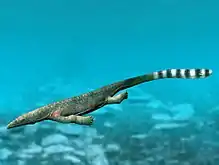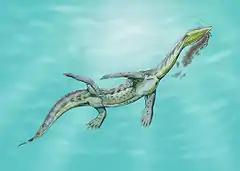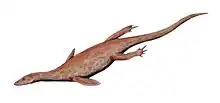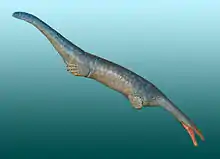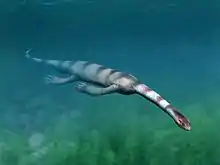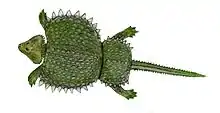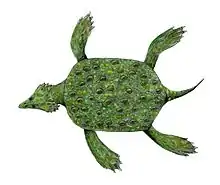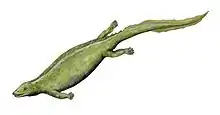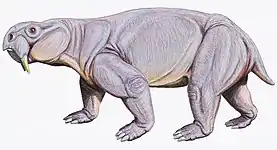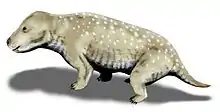Ladinian
The Ladinian is a stage and age in the Middle Triassic series or epoch. It spans the time between 242 Ma and ~237 Ma (million years ago).[7] The Ladinian was preceded by the Anisian and succeeded by the Carnian (part of the Upper or Late Triassic).[8]
| Ladinian | |
|---|---|
| ~242 – ~237 Ma | |
| Chronology | |
Key events in the Triassic -255 — – -250 — – -245 — – -240 — – -235 — – -230 — – -225 — – -220 — – -215 — – -210 — – -205 — – -200 — An approximate timescale of key Triassic events. Axis scale: millions of years ago. (NOTE: The white links are for readability only. They are still clickable.) | |
| Etymology | |
| Name formality | Formal |
| Usage information | |
| Celestial body | Earth |
| Regional usage | Global (ICS) |
| Time scale(s) used | ICS Time Scale |
| Definition | |
| Chronological unit | Age |
| Stratigraphic unit | Stage |
| Time span formality | Formal |
| Lower boundary definition | FAD of the Ammonite Eoprotrachyceras curionii |
| Lower boundary GSSP | Bagolino, Lombardian pre-Alps, Italy 45.8193°N 10.4710°E |
| GSSP ratified | 2005[5] |
| Upper boundary definition | FAD of the Ammonite Daxatina canadensis |
| Upper boundary GSSP | Prati di Stuores, Dolomites, Italy 46.5269°N 11.9303°E |
| GSSP ratified | 2008[6] |
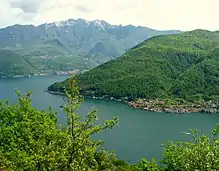
The Ladinian is coeval with the Falangian regional stage used in China.
Stratigraphic definitions
The Ladinian was established by Austrian geologist Alexander Bittner in 1892. Its name comes from the Ladin people that live in the Italian Alps (in the Dolomites, then part of Austria-Hungary).
The base of the Ladinian stage is defined as the place in the stratigraphic record where the ammonite species Eoprotrachyceras curionii first appears or the first appearance of the conodont Budurovignathus praehungaricus. The global reference profile for the base (the GSSP) is at an outcrop in the river bed of the Caffaro river at Bagolino, in the province of Brescia, northern Italy.[9] The top of the Ladinian (the base of the Carnian) is at the first appearance of ammonite species Daxatina canadensis.
The Ladinian is sometimes subdivided into two subages or substages, the Fassanian (early or lower) and the Longobardian (late or upper). The Ladinian contains four ammonite biozones, which are evenly distributed among the two substages:
- zone of Frechites regoledanus
- zone of Protrachyceras archelaus
- zone of Protrachyceras gredleri
- zone of Eoprotrachyceras curionii
Ladinian life
Many Ladinian and Carnian vertebrates have been discovered in the Paleorrota Geopark in Brazil: Rhynchosaurs, thecodonts, exaeretodonts, Staurikosaurus, Guaibasaurus, Saturnalia tupiniquim, Sacisaurus, Unaysaurus, and many others. Paleorrota lies within the Santa Maria Formation and the Caturrita Formation.
Vertebrates of Ladinian age include:
Actinopterygians
| Actinopterygii of the Ladinian | ||||
|---|---|---|---|---|
| Taxa | Presence | Location | Description | Images |
| Triassic | China, Switzerland, Italy | A non-neopterygian |
| |
| Anisian to Carnian | Italy | A perleidiform | ||
| Middle Triassic | Switzerland | |||
| Middle Triassic | Switzerland, Italy | |||
| Middle Triassic | Italy, Switzerland, China | A neopterygian | ||
| Middle Triassic to Late Triassic | Switzerland, Italy | The earliest teleosteomorph (modern ray-fin) | ||
| Middle Triassic to Early Jurassic | Switzerland, Italy | A non-neopterygian | ||
| Triassic | China, Switzerland, Italy | A non-neopterygian | ||
| Middle Triassic to Late Triassic | China | The earliest gliding fish | ||
Coelacanths
| Actinistia of the Ladinian | ||||
|---|---|---|---|---|
| Taxa | Presence | Location | Description | Images |
| Middle Triassic | Spain | A coelacanth |
| |
| Middle Triassic | Switzerland | A coelacanth | ||
| Middle Triassic | Germany | A coelacanth | ||
| Middle Triassic | Switzerland, Italy | A coelacanth | ||
Dipnoi
| Dipnoi of the Ladinian | ||||
|---|---|---|---|---|
| Taxa | Presence | Location | Description | Images |
|
Longobardian, Germany | Erfurt Formation | An extinct but derived lungfish. | |
†Temnospondyls
| Temnospondyli of the Ladinian | ||||
|---|---|---|---|---|
| Taxa | Presence | Location | Description | Images |
| Upper Muschelkalk beds, Germany | A mastodonsaurid temnospondyl. |
| ||
| Russia | A mastodonsaurid temnospondyl. | |||
| Middle Triassic | Germany | A mastodonsaurid. | ||
| Lower Keuper, Staffordshire, England. | A stenotosaurid temnospondyl. | |||
| Middle Triassic | Germany | A trematosaurid temnospondyl. | ||
†Chroniosuchians
| Chroniosuchia of the Ladinian | ||||
|---|---|---|---|---|
| Taxa | Presence | Location | Description | Images |
| Middle Triassic | Germany | A chroniosuchian reptiliomorph |
| |
| Komi Republic, Urals, Russia | A chroniosuchian reptiliomorph. | |||
†Tanystropheids
| Tanystropheids of the Ladinian | ||||
|---|---|---|---|---|
| Taxa | Presence | Location | Description | Images |
| Muschelkalk, Spain | Cosesaurus is a genus of archosauromorph reptiles, likely a juvenile belonging to the family Tanystropheidae. |
| ||
| Falang Formation, southern China. | Fuyuansaurus is an extinct genus of archosauromorph reptiles, probably part of Tanystropheidae. | |||
| late Anisian to Ladinian | China, Switzerland | |||
| Middle Triassic to Late Triassic | China, Europe | |||
Archosauriforms
| Archosaurs of the Ladinian | ||||
|---|---|---|---|---|
| Taxa | Presence | Location | Description | Images |
| Orenburg Oblast, Russia | A basal predatory archosauriform, a member of Erythrosuchidae. |
| ||
| Bashkortostan, Russia | An indeterminate archosaur, possibly a rauisuchid. | |||
| Lower Santa Maria Formation, Paleorrota Geopark, Brazil. | A member of Aphanosauria, basal relatives of dinosaurs and pterosaurs. | |||
| Tongchuan Formation, Shanxi, China | Yonghesuchus was not considered to be a crown-group archosaur, but rather a closely related advanced archosauriform, but in most recent analyses, Yonghesuchus has been recovered as in a well supported clade, the Gracilisuchidae within the Pseudosuchia, along with Gracilisuchus and Turfanosuchus. | |||
| All across Europe | Zanclodon is the name formally used for fossil material that might actually belongs to at least two genera of dinosaur from the Late Triassic among other genera. | |||
Suchians
| Suchians of the Ladinian | ||||
|---|---|---|---|---|
| Taxa | Presence | Location | Description | Images |
| Erfurt Formation, Germany |
| |||
| Santa Maria Formation, Brazil | ||||
| European Russia | ||||
| late Ladinian or Carnian | Clark locality, Wyoming | |||
| Batung Formation, Hunan, China | ||||
| late Ladinian or early Carnian | Chañares Formation, Argentina | |||
| Santa Maria Formation, Brazil | ||||
| Grenzbitumenzone, Switzerland, Italy | ||||
Lepidosauromorphs
| Lepidosauromorphs of the Ladinian | ||||
|---|---|---|---|---|
| Taxa | Presence | Location | Description | Images |
| Erfurt Formation, Germany | An extinct genus of basal lepidosauromorph reptile. | |||
†Thalattosaurs
| Thalattosauria of the Ladinian | ||||
|---|---|---|---|---|
| Taxa | Presence | Location | Description | Images |
| Middle Triassic to Late Triassic | China | An askeptosauroid |
| |
| Middle Triassic to Late Triassic | Canada | A thalattosauroid | ||
| Middle Triassic to Late Triassic | China | A thalattosauroid | ||
†Pistosaurs
| Pistosauria of the Ladinian | ||||
|---|---|---|---|---|
| Taxa | Presence | Location | Description | Images |
| Middle Triassic | France, Germany | A sauropterygian |
| |
†Nothosaurs
| Nothosauroidea of the Ladinian | ||||
|---|---|---|---|---|
| Taxa | Presence | Location | Description | Images |
| Middle Triassic | Italy, Switzerland | Possibly a synonym of Lariosaurus. |
| |
|
Middle Triassic | Europe, China | A sauropterygian | |
| Middle Triassic to Late Triassic | Europe, China | A sauropterygian | ||
| Anisian-Ladinian boundary | Switzerland | Possibly a species of Lariosaurus. | ||
| Middle Triassic | Germany, France | A sauropterygian | ||
†Pachypleurosaurs
| Pachypleurosauria of the Ladinian | ||||
|---|---|---|---|---|
| Taxa | Presence | Location | Description | Images |
| Middle Triassic | China | A sauropterygian |
| |
| Middle Triassic | Italy, Switzerland | A sauropterygian | ||
|
Earliest Ladinian | Switzerland | A sauropterygian | |
| Middle Triassic | China | A sauropterygian | ||
†Placodonts
| Placodonts of the Ladinian | ||||
|---|---|---|---|---|
| Taxa | Presence | Location | Description | Images |
| Middle Triassic | Germany | A sauropterygian |
| |
| Middle Triassic | China | A sauropterygian | ||
| Middle Triassic to Late Triassic | Hungary | A sauropterygian | ||
| Middle Triassic | Italy | A sauropterygian | ||
| Middle Triassic | Egypt; Israel | A sauropterygian | ||
†Ichthyopterygians
| †Ichthyopterygia of the Ladinian | ||||
|---|---|---|---|---|
| Taxa | Presence | Location | Description | Images |
| Middle Triassic | Switzerland | An elongate ichthyosaur |
| |
| Middle Triassic | Switzerland, Italy | An ichthyosaur | ||
| Early Triassic to Middle Triassic | Austria, Italy | An ichthyosauriform with button-like teeth | ||
Therapsids
| Therapsids of the Ladinian | ||||
|---|---|---|---|---|
| Taxa | Presence | Location | Description | Images |
| Paleontological Site Chiniquá, Brazil | A kannemeyeriiform dicynodont. |
| ||
| Ladinian-Carnian | Santa Maria Formation, Brazil | |||
|
Santa Maria Formation, Brazil and Omingonde Formation, Namibia |
A genus of kannemeyeriiform dicynodont in the family Stahleckeriidae. | |||
References
Notes
- Widmann, Philipp; Bucher, Hugo; Leu, Marc; Vennemann, Torsten; Bagherpour, Borhan; Schneebeli-Hermann, Elke; Goudemand, Nicolas; Schaltegger, Urs (2020). "Dynamics of the Largest Carbon Isotope Excursion During the Early Triassic Biotic Recovery". Frontiers in Earth Science. 8 (196): 1–16. doi:10.3389/feart.2020.00196.
- McElwain, J. C.; Punyasena, S. W. (2007). "Mass extinction events and the plant fossil record". Trends in Ecology & Evolution. 22 (10): 548–557. doi:10.1016/j.tree.2007.09.003. PMID 17919771.
- |note5-nudge-down=1 Retallack, G. J.; Veevers, J.; Morante, R. (1996). "Global coal gap between Permian–Triassic extinctions and middle Triassic recovery of peat forming plants". GSA Bulletin. 108 (2): 195–207. doi:10.1130/0016-7606(1996)108<0195:GCGBPT>2.3.CO;2. Retrieved 2007-09-29.
- Payne, J. L.; Lehrmann, D. J.; Wei, J.; Orchard, M. J.; Schrag, D. P.; Knoll, A. H. (2004). "Large Perturbations of the Carbon Cycle During Recovery from the End-Permian Extinction". Science. 305 (5683): 506–9. doi:10.1126/science.1097023. PMID 15273391.
- Brack, Peter; Rieber, Hans; Nicora, Alda; Mundil, Roland (December 2005). "The Global boundary Stratotype Section and Point (GSSP) of the Ladinian Stage (Middle Triassic) at Bagolino (Southern Alps, Northern Italy) and its implications for the Triassic time scale". Episodes. 28 (4). doi:10.18814/epiiugs/2005/v28i4/001. Retrieved 23 December 2020.
- Mietto, Paolo; Manfrin, Stefano; Preto, Nereo; Rigo, Manuel; Roghi, Guido; Furin, Stefano; Gianolla, Piero; Posenato, Renato; Muttoni, Giovanni; Nicora, Alda; Buratti, Nicoletta; Cirilli, Simonetta; Spötl, Christoph; Ramezani, Jahandar; Bowring, Samuel (September 2012). "The Global Boundary Stratotype Section and Point (GSSP) of the Carnian Stage (Late Triassic) at Prati Di Stuores/Stuores Wiesen Section (Southern Alps, NE Italy)" (PDF). Episodes. 35: 414–430. Retrieved 13 December 2020.
- http://www.stratigraphy.org/index.php/ics-chart-timescale
- For a detailed geologic timescale see Gradstein et al. (2004)
- The GSSP was established by Brack et al. (2005)
Literature
- Brack, P.; Rieber, H.; Nicora, A. & Mundil, R.; 2005: The Global boundary Stratotype Section and Point (GSSP) of the Ladinian Stage (Middle Triassic) at Bagolino (Southern Alps, Northern Italy) and its implications for the Triassic time scale, Episodes 28(4), pp. 233–244.
- Gradstein, F.M.; Ogg, J.G. & Smith, A.G.; 2004: A Geologic Time Scale 2004, Cambridge University Press.
External links
- GeoWhen Database - Ladinian Archived 2010-08-22 at the Wayback Machine
- Upper Triassic and Lower Triassic timescales, at the website of the subcommission for stratigraphic information of the ICS
- Norges Network of offshore records of geology and stratigraphy: Stratigraphic charts for the Triassic, and
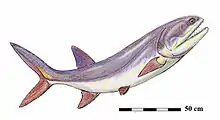

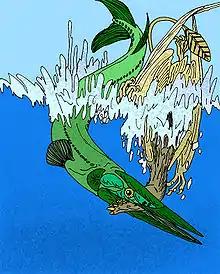
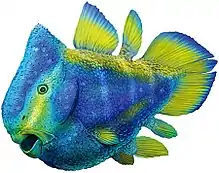
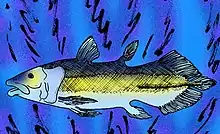


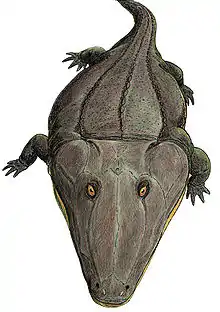

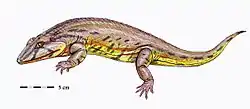
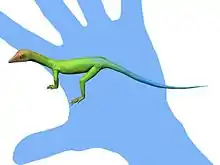


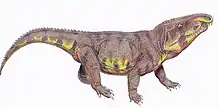
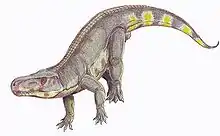
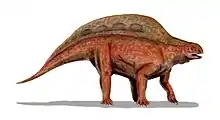
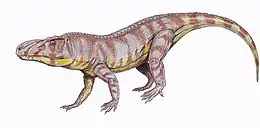
.jpg.webp)

